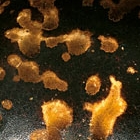J.J. Lally & Co., Oriental Art / New York City, New York
MenuPast Exhibition
SONG DYNASTY CERAMICS:
The Ronald W. Longsdorf Collection
March 15 - April 13, 2013
37.
A JIZHOU ‘TORTOISESHELL’-GLAZED BOWL
Song Dynasty (A.D. 960-1279)
with steeply rounded sides covered inside and out with a lustrous dark brown glaze liberally splashed with caramel-yellow and reddish-brown markings, the upturned rim with some pale markings all around, the dark glaze continuing down to the edge of the very shallow ring foot, the base and footrim unglazed, revealing the buff pottery.
Diameter 4 inches (10.2 cm)
A similar Jizhou ‘tortoiseshell’-glazed tea bowl with wider, slightly everted rim is illustrated by Tseng and Dart in The Charles B. Hoyt Collection in the Museum of Fine Arts: Boston, Vol. II, Boston, 1972, no. 135. Another similarly glazed Jizhou tea bowl in the collection of the Tokyo National Museum is illustrated by Tregear, Song Ceramics, London, 1982, p. 195, no. 266; see also a similar Jizhou tea bowl in the collection of the Ashmolean Museum, Oxford, illustrated by Tregear, op. cit., p. 198, pl. 269.
Compare also the larger Jizhou ‘tortoiseshell’-glazed bowl illustrated by Mowry in Hare’s Fur, Tortoiseshell, and Partridge Feathers: Chinese Brown- and Black-Glazed Ceramics, 400-1400, Cambridge, 1996, pp. 225-228, no. 87, with a lengthy caption including a detailed discussion of the various alternative techniques which scholars have proposed as the most likely method by which the ‘tortoiseshell’ glaze was created at the Jizhou kilns.
宋 吉州玳瑁釉盞 徑 10.2 厘米
